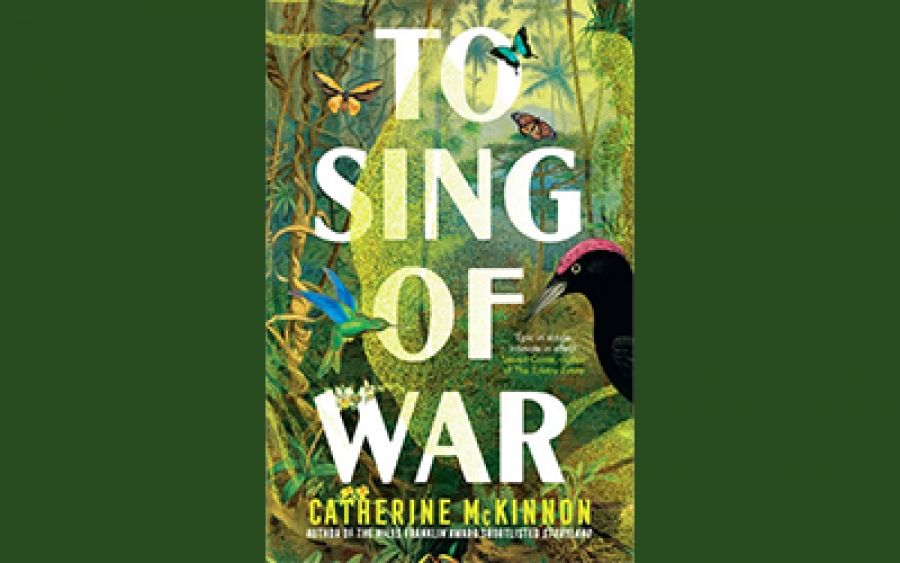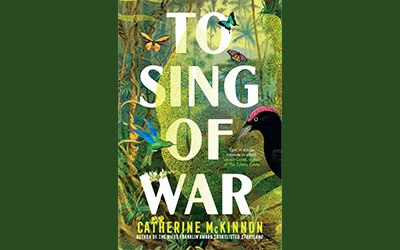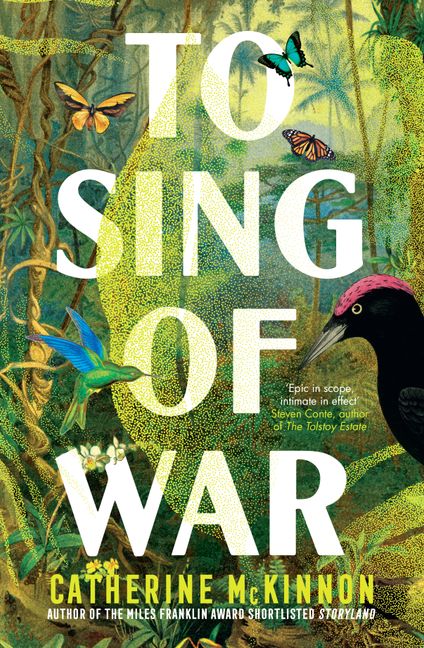
- Free Article: No
- Contents Category: Fiction
- Review Article: Yes
- Article Title: ‘I am the jungle’
- Article Subtitle: A deft take on Virgil
- Online Only: No
- Custom Highlight Text:
In an exquisite, braided narrative, Catherine McKinnon’s To Sing of War reanimates World War II in a paean to the environment. Set between December 1944 and August 1945, the narrators experience the ways ‘Violence is malleable, it is everywhere’, but find healing and resilience in ‘the heart of the earth’. Importantly, Virgil’s epic poem, The Aeneid, is the key intertext and provides the central conceit and structure for the novel. Where The Aeneid concerns the building of Rome after the destruction of Troy, closely linking the fates of the two cities, To Sing of War grapples with rebuilding lives in a post-atomic world.
- Featured Image (400px * 250px):

- Alt Tag (Featured Image): Cassandra Atherton reviews ‘To Sing of War’ by Catherine McKinnon
- Book 1 Title: To Sing of War
- Book 1 Biblio: Fourth Estate, $32.99 pb, 454 pp
- Book 1 Cover Small (400 x 600):

- Book 1 Cover (800 x 1200):

In the prime and most indelible of the narratives, Lotte and Virgil are reunited in New Guinea. Originally childhood sweethearts, Lotte has become a nurse and Virgil is a soldier fighting the Japanese in the jungle. His father names him after the poet because of his ‘long-held belief, evoked in the story, that any hardship can be overcome if one perseveres, faces it stoically’. Virgil has a copy of The Aeneid on the battlefield and, at crucial junctures, juxtaposes his experiences with some of those recounted in the poem. In a less experienced writer’s hands, this might have become self-conscious or pretentious; however, McKinnon’s deft touch ensures that when ‘Virgil reads The Aeneid to the [soldiers] … I sing of arms and of a man … I sing of war’, it is a truly salutary and moving passage.
Perhaps because of this, when Robert Oppenheimer – one of the narrators of the second of the novel’s interconnected narratives – is likened to Aeneas, ‘leading us to a new land, a new home, a way of being’, it is an empty, rather than a chilling, moment. There are three narrators of the sections set in Los Alamos – the other two are Oppenheimer’s wife, Kitty, and the young physicist Mim. Indeed, Mim is such a complex and feisty character that she could easily have carried the entire section of this narrative on her own. Because Robert and Kitty are historical figures (made even more famous by the recent blockbuster film Oppenheimer), their characterisation is somewhat constrained by the facts connected to their lives, whereas the depiction of Mim, who is one of few women physicists working on the atomic bomb, is written with insight and panache.
Finally, in Miyajima, an island in Hiroshima Bay, Hiroko waits with her family for her husband, Kenzo, to return from the war. McKinnon creates some gorgeous, lyrical passages about the environment for this character. They are focused on transience and a deep understanding of the natural world: ‘Hiroko can hear the earth shifting and sighing. Falling snow covers the branches that form a thick canopy above. Everything jingles as the wind whips through the trees and the air is scented with air earth and bark.’
This troping on the natural environment is reiterated in references to the song ‘sakura sakura’, meaning cherry blossom, that haunts the text, and which is also inextricably linked to gender, precarity, and war. McKinnon has crafted so many extraordinary passages on ecofeminism and intersectional environmentalism that it is difficult to particularise. Lotte makes some of the starkest observations, and it is through this nuanced character that McKinnon challenges the enduring stereotype of women not being ‘fit for war’:
Women are always at war. Always under threat. She can’t remember a time when she felt safe, completely safe, for longer than a few days. Safety has always been temporary. Is it only her or is it all women? The daily terror so normalised that it has become habitual to fend it off. She does not want to go her whole life feeling like a hunted animal.
Animals, especially birds, are totems and omens for characters in To Sing of War. McKinnon makes a compelling case for a greater consideration of the animals’ experiences of war, as well as war’s destructive environmental effects. Numerous animals are innocent victims of armed conflict; in particular, McKinnon flags how the loss of wildlife has enormous environmental consequences. Furthermore, ordnance from the war – such as shells and bullets – often remains in the environment long after it has been fired and introduces heavy metals and other contaminants into the earth. When characters such as Lotte, Virgil, and Hiroko are described in metaphorical terms as various animals, or have encounters with the environment, McKinnon implicitly asks the reader to consider all living things in human conflict and battle.
McKinnon’s various critiques of oppressive gender hierarchies coalesce in Virgil’s statement about the nature of violence, which boldly brings the novel’s multifarious narrative strands together:
But where violence comes from is deeper, hidden. Not just in men’s hearts, but in systems, in language. What sets it off doesn’t even look violent. It’s greed and selfishness and self-obsession. Most dangerous is revenge. Violence is small fears that grow into big ones and explode. Everything starts small, at the level of an atom, that’s the thing.
Importantly, To Sing of War includes powerful depictions of Virgil’s encounters with Japanese soldiers, where he tellingly asks himself, ‘If he were Japanese, could this be the same story? Is war always the same plot, just different characters?’ However, it is the moments when characters empathise with the environment and when McKinnon demonstrates a poignant awareness of the place of humans on an increasingly fragile planet that are deeply uncanny and unforgettable: ‘I am the jungle, he thinks. I am mud, tree, leaf; I am vine, insect, bird. He hears nocturnal calls, responds by mimicking an owl hoot.’


Comments powered by CComment